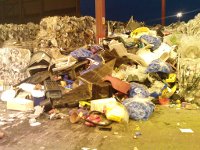Pushing into the future
Bioplastics today already offer many advantages when compared to petrolplastics, but the potential for bioplastics to become better has set the stage for it to make further gains. One key will be weaning the production of bioplastics from food products, and it will be a huge challenge.

 Bioplastics today already offer many advantages when compared to petrolplastics, but the potential for bioplastics to become better has set the stage for it to make further gains.
Bioplastics today already offer many advantages when compared to petrolplastics, but the potential for bioplastics to become better has set the stage for it to make further gains.
One key will be weaning the production of bioplastics from food products, and it will be a huge challenge. But change is within sight as technology races demands for clean, sustainable, and cost-equivalent alternatives to conventional plastic.
There are at least two roads to second-generation bioplastic production being explored: using genetically modified plants to grow polymers, and converting cellulose found in agricultural waste into bioplastic resin.
Using genetic modification (GM) is controversial, because, particularly in Europe, it is believed that GM crops can introduce disruptive and unnatural elements into ecosystems.
For this reason and the irreversibility of introducing man-made genes into the environment, research is ongoing. Yet, the potential for GM bioplastics is enormous. It is possible to add genes from microbes used in bioplastic production directly into certain plants.
One US company is using a native tall grass called switchgrass and has witnessed success.
Plastic pellets can be extracted directly from the plant's leaves to make Polyhydroxyalkanoate (PHA), a bioplastic that has the potential to replace petrolplastic in a variety of medical and packaging application.
Direct circumvents the time and energy consuming process of fermentation. PHA, like PLA, is also 100% biodegradable. If the first generation bioplastic industry is still in its infancy, cellulosic bioplastics have yet to leave the womb.
In 2008, the Fraunhofer Institute for Chemical Technology ICT received media attention for building a nativity scene from a polymer dubbed "liquid wood".
The second-generation bioplastic figurines demonstrate the potential and limitations that cellulosic bioplastics offer.
Liquid wood is produced when wood is separated into its three constituent parts: lignin, cellulose, and hemicellulose. Researchers can mix lignin with natural fibres from wood, hemp, flax, and wax to make a resin that can be injection moulded.
Car parts can already be manufactured with the liquid wood, but the so far the industry is limited in versatility. They make an impractical replacement for children's toys for example.
In order to separate lignin from cellulosic fibres, sulphur-rich chemicals are employed, which creates the rather unpleasant smell of rotten eggs. Without sulphur, the polymer becomes soluble in water, and therefore poses a particular threat to children that are accustomed to placing plastic toys in their mouths.
Liquid wood is reportedly 100% recyclable and offers the first glimpse of how scientists are learning to utilise plant waste to build the future's plastics. First and second generation bioplastics are finding versatile application for the future.
Demand for solar energy has reached its highest pitch yet. However, solar panels are manufactured from silicon and petrolplastic, which generates costly industrial waste.
Until recently, bioplastics could not sustain the temperatures that a solar panel demands. But breakthroughs in the last two years have allowed PLA to be combined with silicon, making a thin, light and practical polymer.
While the bioplastic industry as a whole is in the mist of unprecedented expansion, it is less certain how high and in which direction it will grow. With technology beginning to harness the potential of bioplastics and governments and companies embracing environmentally safe plastic alternatives, it is clear that bioplastics will have an increasingly important role in our future.
Author: Michael Good |Climate Action
Image: Steve Bullivant |Flickr



_400_250_80_s_c1.jpg)


